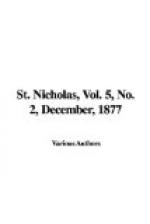Yes. It’s so; though I must say I felt inclined to laugh the first time I heard one boy tell another to put salt on a bird’s tail by way of catching it. Now, however, word comes, all the way from California, that there is a lake there, called “Deep Spring Lake,” whose waters are very salt; and that during certain conditions of the weather the water-fowl of the lake become so encrusted with salt that they cannot fly, and the Indians wade into the water and simply catch the birds with their hands. The coating taken from one duck weighed six pounds,—enough to have drowned it, even if its eyes and bill had not been so covered as to blind and choke it. When the weather is favorable for the formation of this crust upon the birds, the Indians do their best with fires and noise to keep them away from the few fresh-water streams where the poor things would be safe from the salt. Besides this, the savages imitate the cries and calls of the birds, so as to entice them to the dangerous part of the lake.
It seems to me that men must be very mean as well as very hungry to take advantage of the birds in that way. However, “circumstances alter cases,” as the school-boy said when he had been “punished for his good” by mistake.
A SPELL UPON KEROSENE.
Bridgeport, Conn.
Dear Little Schoolma’am: One would think that the word “kerosene” could not be a very difficult one for the average inhabitant to write correctly; but it is. From the New York Independent I learn that the following versions of the word have actually been received by the Portland Kerosene Oil Company in its correspondence:
Caracine, carecane, caroziene, carocine, cursene, carozyne, coriseen, carosyne, caricien, carsine, caresene, carozine, carocene, carosean, carycene, caresien, caraseen, caroscene, crosen, carecene, carizoein, keriscene, karosin, kerocine, keressean, keriseene, kerasene, kerosen, kereseen, kerison, kerriseen, kerricene, keroseen, kerosine, karosina, keresene, kerrsein, keroscene, kerose, kerasseen, kereson kerocene, kerozene, kerrisene, kerryseen, kerissien, kersien, kerossein, keriscene.
Now isn’t that astonishing?—Yours sincerely,
MARY N.G.
THE EYEBROW WORD.
What do you think this is? It is neither more nor less than the word “supercilious,” which is derived from supercilium, the Latin for “eyebrow,” as I heard the Little Schoolma’am tell the children not long ago.
When she had said this, one of the little girls, in a rather scornful, superior way, said, “I don’t see any sense in that.” Whereat the Little Schoolma’am and two or three of the bigger girls laughed, for the little girl had raised her eyebrow in a most “supercilious” expression, giving the best possible proof of the appropriateness of the word. For, certainly, it is hard for one’s face to express a supercilious feeling without raising the eyebrow, or at least changing that part of the countenance which is over the eyelid.




